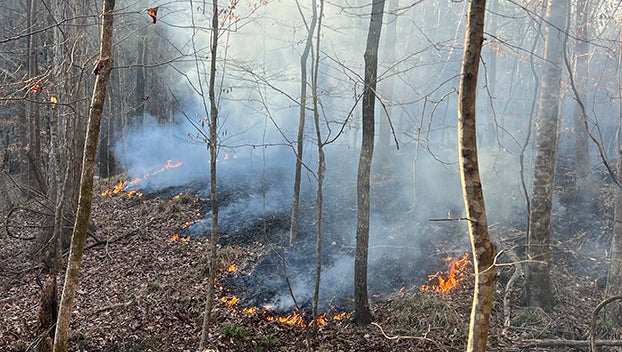Spring thunder is approaching, the work to sustain it starts now
Published 4:29 pm Thursday, February 16, 2023

- A fire works its way through the understory of a timber stand in Lincoln County. Prescribed fire encourages new plant growth of forbes and browse which provide food to deer and benefit turkeys. Dormant season fire is one of a few windows land owners can use prescribed burning to improve habitat but growing season fire in June and July can also be utlitized. (Hunter Cloud | The Daily Leader)
BROOKHAVEN — Clover, pokeweed and perennials are starting to make their presence known this February by painting fields of hibernating brown grass with undertones of lively green. Trees might be a month away from producing green leaves but the growing season is starting to draw near.
By February 28, Brookhaven will have 12 hours of sunlight as the first day of spring nears. According to an article written by MDWFP turkey program coordinator Adam Butler, turkeys detect the growing amount of daylight.
“Increased daylight stimulates receptors in the hen’s eyes. This causes a response from her endocrine system and begins the production of certain hormones that signal her body that the breeding season is near,” Butler wrote. “Many physiological changes must occur for the hen’s body to be ready for egg production. Behavioral differences will take place as well. Sometime in early March, a great deal of shuffling will occur within the local turkey population, and the hen and most of her winter flock will suddenly part ways.”
The splitting up of hens leads to the crazy breeding action seen in Mississippi’s spring woods as gobblers and hens get to business. It only takes one successful mate for a hen to have all of her eggs fertilized.
Hens are able to lay fertilized eggs up to two months after they have mated with a gobbler in the spring according to Butler’s article. Food needs for hens change during the spring time leading up to her laying eggs. A hen needs up to 180 percent more energy during this time and gets the energy from insects such as grasshoppers.
Providing quality habitat is important for what comes next and the time to help hens when they are most vulnerable sitting on their eggs night and day for nearly a month is now. Hens need cover to protect them from predation above and on the ground and to protect her eggs.
One way to provide cover is to encourage briar growth with some brushy cover in spots where hens won’t be obvious to predators. They need about three to four feet of vertical cover to conceal the hen and once the turkey poults hatch a hen needs to be able to see her brood. About three quarters of the poults born will die before they reach 14 days old. Better cover and food will help more poults reach 17 days old when they can fly off the ground, greatly increasing chances of survival. Good poult production eventually results in better harvests down the road.
Prescribed fire is one way to encourage this growth either in an old field or in timber stands. If the stand does not have any undergrowth of cover it is in need of burning and thinning of the forest canopy. Disking of fields can also encourage the early succession growth.
While summer is months away and the nests, poults and brooding habitat is months away from coming to fruition, it should be noted that mowing greatly hurts the poults’ chances of survival. Mowing not only puts turkeys at risk of predation and being hit by a tractor but it could cause increased mortality of fawns.
Land owners, hunters and habitat managers who encourage early successional growth create habitat which benefits turkeys, deer, quail, song birds and rabbits. Spring turkey season is right around the corner but the time to work on improving habitat is now. Those interested in prescribed fire and how to properly use it can visit the Mississippi Forestry Commission website for more information. A burn permit may be required.




